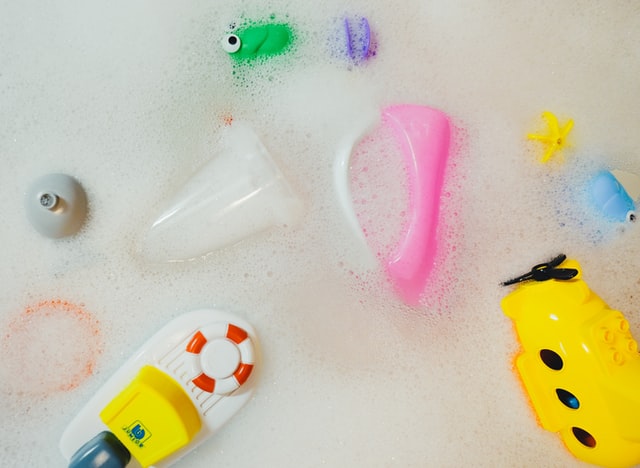The one thing you’ve probably realized as a parent is that kids are notoriously messy. Mess and germs are unavoidable in your life, whether it’s blowout diapers or food disasters. During playdates, your child’s toys travel in the car with them, get sucked up by them, and get thrown around by their other friends.This article includes recommendations from Mustela’s baby specialists about how to clean the baby’s toys while simultaneously being ecologically conscious.
Table of Contents
Toys Should Clean or Sanitize
It is necessary to clean various toys in a specific manner. Learn how to clean each of your baby’s toys by following these instructions:
Soft toys and stuffed animals are a great option
To make matters worse, the materials that stuffed toys are made of can become filthy and can also act as a collection point for germs.
Cleaning Baby Toys Procedures
Cleaning these toys with water and soap and your hands is typically sufficient. The use of a washing machine is another option that is convenient. Because your baby will be playing with them later, do not use your regular soap for it. Use only the baby shampoo and allow them to dry outside in the sun. Alternatively, you can put them all in a cloth and wash them on the gentle cycle in the washing machine.
Toys for the Bath
In addition, all of the ducks and boats that your child enjoys playing with during bath time must be washed. In addition, they are constantly exposed to moisture and are in close proximity to both clean and polluted water sources.
In most cases, bath toys are left wet all of the time, creating an environment conducive to microbe proliferation. Given that your child bathes and plays with them on a daily basis, it is important that they are cleaned on a daily basis as well. After each bath, wash them thoroughly and set them aside to dry or hang them on a drying wire to air dry overnight. To clean them in a hurry, you can submerge them overnight in a homemade cleaning solution and then allow them to air dry.
Toys made of plastic
All children enjoy playing with plastic toys, which are available in a variety of shapes and sizes. As a result, it is necessary to remove them from the vehicle and cover the battery portion while cleaning them.
Cleaning Procedures of Plastic Baby Toys
Most plastic toys can be cleaned with hot water and a little soap, or even with a dish detergent if they are not too dirty. Toys that are entirely made of plastic and have no fabric on them are the best candidates for this type of treatment. Place these toys on a clothing tray so that the water can easily drip down from the top of them. Wash items in the washer on a mild cycle for one short amount of time and then hang clothes to air dry.An old toothbrush can be used to thoroughly clean the insides of any toys that have small moving parts, such as dolls.
Toys made of rubber
It is quite simple to play with rubber toys. As opposed to hard plastic toys, these are more forgiving to the baby’s hands and can be handled more easily. The downside to this is that they can easily acquire and retain a large number of germs on body.
Cleaning Procedures
In addition to rubber toys, soapy water can be used to clean them too. Allow them to soak in the soapy water for an hour or so before washing them to allow the soap to work its magic on the grime and grime.
Chemicals that are safe for the environment
Despite the fact that some cleaners contain harsh chemicals that are effective at removing germs, many parents are concerned about their children coming into contact with them.
- Baby toy cleaners that are dye-free, biodegradable, and free of phthalates and parabens are the best bets for parents. Cleaning products that are environmentally friendly are preferred because babies and toddlers chew on their toys.
- Make use of a disinfectant surface wipe to clean the toy.
- After allowing it to air dry for a few minutes, you can hand it over to a child to play with.
- Pacifier wipes are specially formulated for items such as pacifiers. It is safe for babies to put items in their mouths because these sanitizers are food-grade.
Bath Toys: How to Care for Them
A vital component of your baby’s toy cleaning regimen is cleaning his or her bath toys. Proper cleaning and care of your bath toys are essential in order to prevent mildew from forming inside them. Because of their exposure to water and humidity, bath toys can become breeding grounds for a wide variety of mildew and germs. To keep water out, control the humidity level in which the toys live, and give them a bath, you must first seal the opening.
Cleaning baby toys by boiling them is an efficient method of disinfection
Take note that this procedure would not work with toys made of soft, flexible plastic. When boiling items such as pacifiers or hard plastic toys (such as silicone toys), baby bottles, or other items that will not melt or release chemicals, you should use caution.
You’ll need the following supplies:
- Water
- Pot that is large
- Tongs
Follow these steps to complete the project:
- Prepare a large pot of water by boiling it for several minutes on high heat.
- Remove the toys from the oven and place them in a bowl of ice water for an hour to stop the cooking process.
- Remove toys with a tong or other similar utensil after 5-10 minutes of waiting.
- Place the container on a cooling rack and allow it to air dry completely before using the container.
